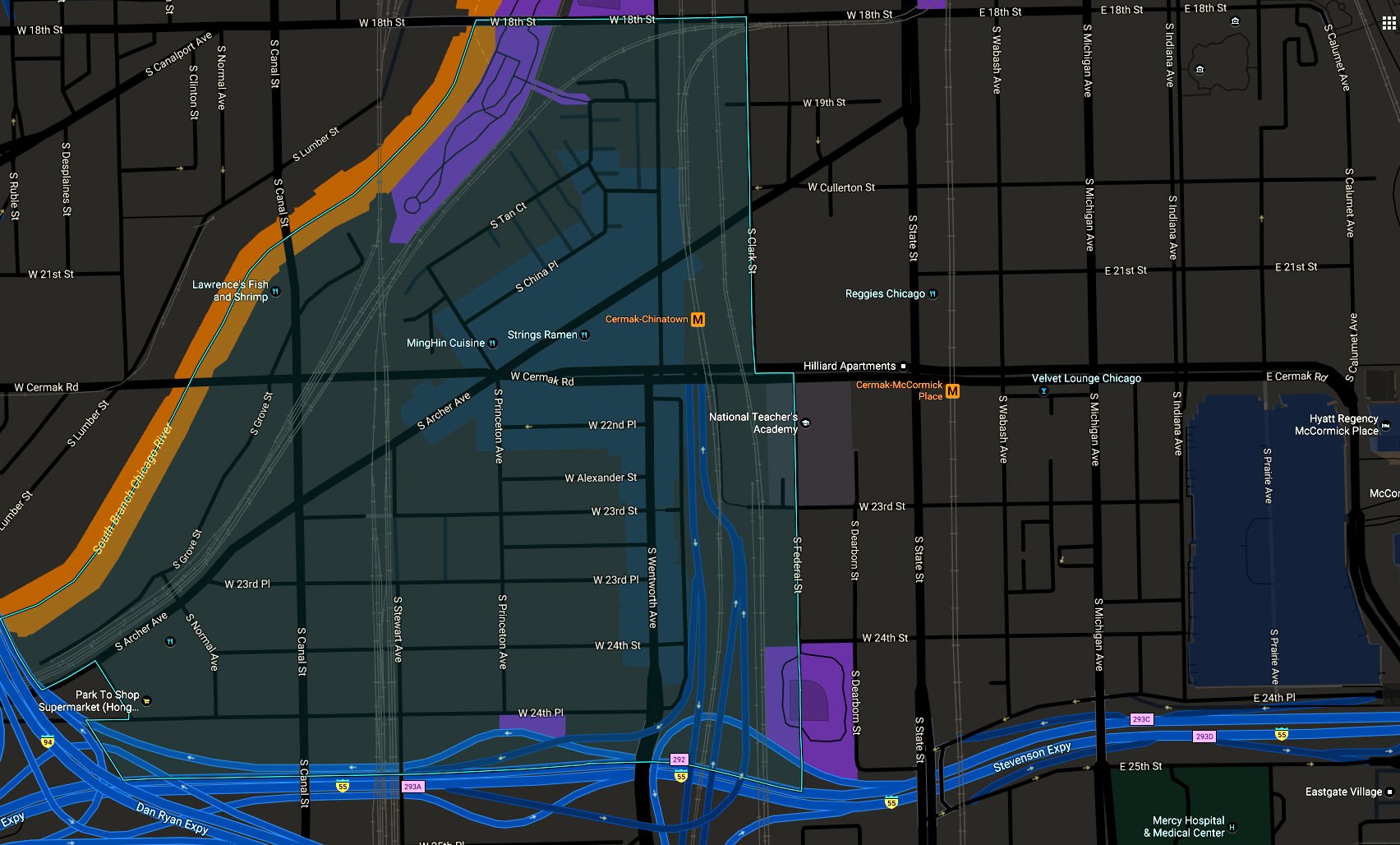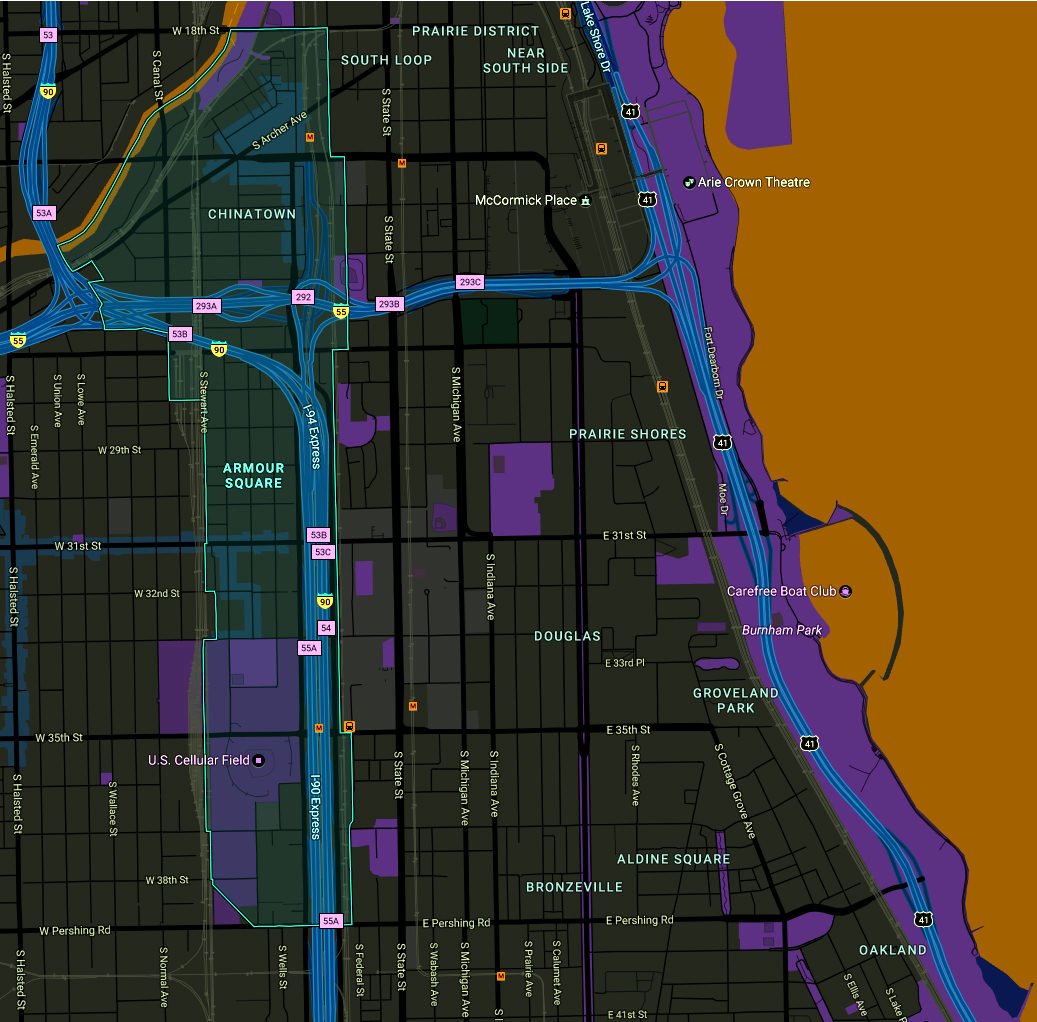Armour Square
Contents
Armour Square neighborhood
Bounded by 18th Street to the north, Pershing Road to the south, the Union Pacific railroad tracks on the west and the Dan Ryan Expressway to the east, Armour Square has historically been a predominantly white, working-class neighborhood with a particularly significant population of both Italian-Americans and Croatian-Americans. With its location being immediately south of Chinatown, today the neighborhood also has a large Asian population as well. Armour Square's most recognizable landmarks are the historic Armour Square Park and nearby US Cellular Field, which sits at the southeast corner of W.35th and Shields Avenue, on the neighborhood's southernmost end. US Cellular is home to the Major League Baseball franchise, the Chicago White Sox. There are three Catholic parishes in Armour Square: Santa Lucia, St. Therese Catholic Community at 218 W Alexander St., and St. Jerome Croatian Catholic Church. The southernmost census tract in the area (3406) is 99% black or African America.
The Chicago White Sox
In 1900, Charles Comiskey moved his St. Paul Saints to Chicago, where they became the team now known as the Chicago White Sox. They began play at the South Side Park on 39th Street in Armour Square, and have remained in the neighborhood ever since. No other major professional sports franchise has played in the same neighborhood longer than the White Sox. In 1910, Comiskey Park opened just 4 blocks north of South Side Park on a site that was formerly a junkyard.The Park remained the home of the Sox until 1990, when it was the oldest park in Major League Baseball. The new Comiskey Park, currently known as U.S. Cellular Field, opened in 1991 across 35th Street from the old ballpark. Comiskey Park was then demolished in 1991 and converted into a parking lot. A plaque embedded in the asphalt marks the spot where home plate was on the original field.
Chicago's Chinatown
The Chinatown neighborhood in Chicago is on the South Side (located in the Armour Square community area), centered on Cermak and Wentworth Avenues, and is an example of an American Chinatown, or ethnic-Chinese neighborhood. By the 2000 Census, Chicago Primary Metropolitan Statistical Area had 68,021 Chinese. The combined 60616 and 60608 zip codes in Chicago, as of the 2010 Census, were home to 22,380 people of Chinese descent. In addition, as of 2010, the Chicago-Joliet-Naperville IL-IN-WI metro area had 92,712 people of Chinese descent. Chicago is the second oldest settlement of Chinese in America after the Chinese fled persecution in California. The present Chicago Chinatown formed about 1915, after settlers moved steadily south from near the Loop where the first enclaves were established in the 19th century.
Chinatown is sometimes confused with an area on the city's North Side sometimes referred to as "New Chinatown", which is centered on Argyle Street and is somewhat of a misnomer given that it is largely represented by people of Southeast Asian heritage.
The History of Chicago's Chinatown

Looking to escape the anti-Chinese violence that had broken out on the west coast, the first Chinese arrived in Chicago after 1869 when the First Transcontinental Railroad was completed. By the late 1800s, 25% of Chicago's approximately 600 Chinese residents settled along Clark Street between Van Buren and Harrison Streets in Chicago's Loop.[6] In 1889, 16 Chinese-owned businesses were located along the two-block stretch, including eight grocery stores, two butcher shops and a restaurant. In 1912, the Chinese living in this area began moving south to Armour Square. Some historians say this was due to increasing rent prices. Others see more complex causes: discrimination, overcrowding, a high non-Chinese crime rate, and disagreements between the two associations ("tongs") within the community, the Hip Sing Tong and the On Leong Tong. The move to the new South Side Chinatown was led by the On Leong Merchants Association who, in 1912, had a building constructed along Cermak Avenue (then 22nd Street) that could house 15 stores, 30 apartments and the Association's headquarters. While the building's design was typical of the period, it also featured Chinese accents such as tile trim adorned with dragons.
During the late 1980s, a group of Chinatown business leaders bought 32 acres (130,000 m2) property north of Archer Avenue from the Santa Fe Railway and built Chinatown Square, a two-level mall consisting of restaurants, beauty salons and law offices, flanked by 21 new townhouses. Additional residential construction, such as the Santa Fe Gardens, a 600-unit village of townhouses, condominiums and single-family homes still under construction on formerly industrial land to the north. Perhaps the most outstanding feature of the new addition was the creation of Ping Tom Memorial Park in 1999; located on the bank of the Chicago River, the park features a Chinese-style pavilion that many consider to be the most beautiful in the Midwest.
Chinatown Commerce
Chicago's Chinatown is home to a number of banks, Chinese restaurants, gift shops, grocery stores, Chinese medicine stores, as well as a number of services that cater to people interested in Chinese culture, including those speaking varieties of Chinese, especially Cantonese. It is a community hub for Chinese people in the Chicago metropolitan area, a business center for Chinese in the Midwest, as well as a popular destination for tourists and locals alike.
